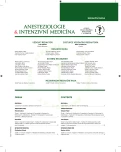Initial experience with adenosin-induced circulatory arrest during cerebral artery aneurysm surgery – first experience
Authors:
M. Černý V.sameš * 1,2,3,4,* 5; T. Radovnický 5; P. Vojtíšek 1
Authors‘ workplace:
Klinika anesteziologie, perioperační a intenzivní medicíny, Univerzita J. E. Purkyně v Ústí nad Labem, Masarykova nemocnice v Ústí nad Labem, Institut postgraduálního vzdělávání ve zdravotnictví
1; Centrum pro výzkum a vývoj, Fakultní nemocnice Hradec Králové
2; Dept. of Anesthesia, Pain Management and Perioperative Medicine, Dalhousie University, Halifax, Canada
3; Klinika anesteziologie, resuscitace a intenzivní medicíny, Univerzita Karlova v Praze, Lékařská fakulta v Hradci Králové
4; Neurochirurgická klinika, Univerzita J. E. Purkyně v Ústí nad Labem, Masarykova nemocnice v Ústí nad Labem
5
Published in:
Anest. intenziv. Med., 27, 2016, č. 1, s. 15-18
Category:
Anaesthesiology - Case Report
Overview
The presented case report describes the first use of adenosine-induced transient circulatory arrest in a patient undergoing cerebral aneurysm clipping in the Czech Republic. Short episodes of circulatory arrest improved surgical conditions (as assessed by the surgeon) without any apparent complications during surgery. The cumulative length of circulatory arrest was 47 seconds; the total dose of administered adenosine was 90 mg. The postoperative course was uneventful and the patient was discharged home with a good functional status. Current scientific evidence in this field and key practical points of this technique are discussed.
Keywords:
cerebral aneurysm clipping – adenosin – asystole
Sources
1. Groff, M. W., Adams, D. C., Kahn, R. A., et al. Adenosine--induced transient asystole for management of a basilar artery aneurysm. Case report. J. Neurosurg., 1999, 91, 4, p. 687–690. Available at: http://www.ncbi.nlm.nih.gov/pubmed/10507394 [Accessed August 31, 2015].
2. Guinn, N. R., McDonagh, D. L., Borel, C. O., et al. Adenosine--induced transient asystole for intracranial aneurysm surgery: a retrospective review. J. Neurosurg. Anesthesiol., 2011, 23, 1, p. 35–40. Available at: http://www.ncbi.nlm.nih.gov/pubmed/20706138 [Accessed August 31, 2015].
3. Bendok, B. R., Gupta, D. K., Rahme, R. J., et al. Adenosine for temporary flow arrest during intracranial aneurysm surgery: a single-center retrospective review. Neurosurgery, 2011, 69, 4, p. 815–820; discussion 820–821.
4. Khan, S. A., McDonagh, D. L., Adogwa, O., et al. Perioperative cardiac complications and 30-day mortality in patients undergoing intracranial aneurysmal surgery with adenosine-induced flow arrest: a retrospective comparative study. Neurosurgery, 2014, 74, 3, p. 267–271; discussion 271–272.
5. Benech, C. A., Perez, R., Faccani, G., et al. Adenosine-induced cardiac arrest in complex cerebral aneurysms surgery: an Italian single-center experience. J. Neurosurg. Sci., 2014, 58, 2, p. 87–94.
6. Heppner, P. A., Ellegala, D. B., Robertson, N., et al. Basilar tip aneurysm – adenosine induced asystole for the treatment of a basilar tip aneurysm following failure of temporary clipping. Acta Neurochir. (Wien). 2007, 149, 5, p. 517–520; discussion 520–521.
7. Powers, C. J., Wright, D. R., McDonagh, D. L., et al. Transient adenosine-induced asystole during the surgical treatment of anterior circulation cerebral aneurysms: technical note. Neurosurgery, 2010, 67, 2 Suppl Operative, p. 461–470.
8. Luostarinen, T., Takala, R. S. K., Niemi, T. T., et al. Adenosine-induced cardiac arrest during intraoperative cerebral aneurysm rupture. World Neurosurg, 2010, 73, 2, p. 79–83; discussion e9.
Labels
Anaesthesiology, Resuscitation and Inten Intensive Care MedicineArticle was published in
Anaesthesiology and Intensive Care Medicine

2016 Issue 1
Most read in this issue
- Metabolic consequences of bowel damage in intensive care
- Initial experience with adenosin-induced circulatory arrest during cerebral artery aneurysm surgery – first experience
- Consciousness as a cosmic phenomenon
- Evaluation of Patients With Suspected Acute Pulmonary Embolism: Best Practice Advice From the Clinical Guidelines Committee of the American College of Physicians
